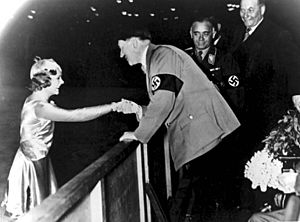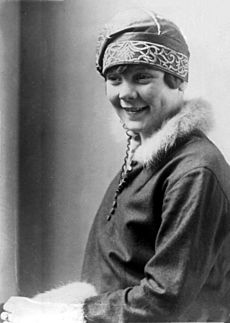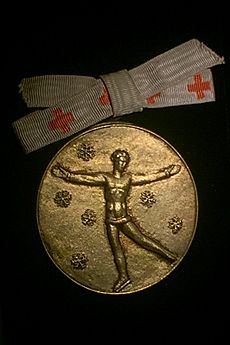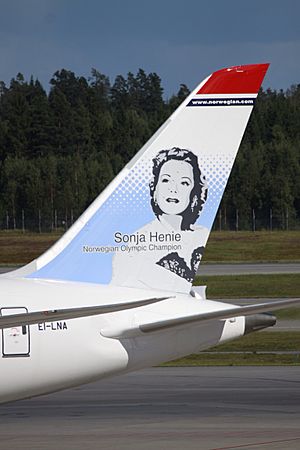Sonja Henie facts for kids
Quick facts for kids Sonja Kay Henie |
|||||||||||||||||||||||||||||||||||||||||||||||||||||||||||||||||||||||||||||
|---|---|---|---|---|---|---|---|---|---|---|---|---|---|---|---|---|---|---|---|---|---|---|---|---|---|---|---|---|---|---|---|---|---|---|---|---|---|---|---|---|---|---|---|---|---|---|---|---|---|---|---|---|---|---|---|---|---|---|---|---|---|---|---|---|---|---|---|---|---|---|---|---|---|---|---|---|---|
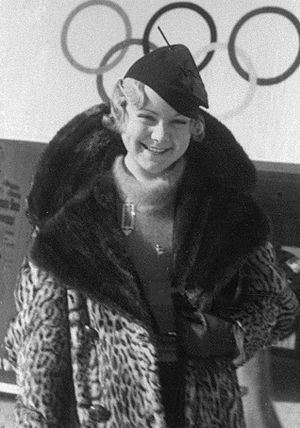
Henie at the 1936 Olympics
|
|||||||||||||||||||||||||||||||||||||||||||||||||||||||||||||||||||||||||||||
| Personal information | |||||||||||||||||||||||||||||||||||||||||||||||||||||||||||||||||||||||||||||
| Full name | Sonja Henie | ||||||||||||||||||||||||||||||||||||||||||||||||||||||||||||||||||||||||||||
| Country represented | |||||||||||||||||||||||||||||||||||||||||||||||||||||||||||||||||||||||||||||
| Born | 8 April 1912 Oslo, Norway |
||||||||||||||||||||||||||||||||||||||||||||||||||||||||||||||||||||||||||||
| Died | 12 October 1969 (aged 57) on a plane flying from Paris to Oslo |
||||||||||||||||||||||||||||||||||||||||||||||||||||||||||||||||||||||||||||
| Height | 1.55 m (5 ft 1 in) | ||||||||||||||||||||||||||||||||||||||||||||||||||||||||||||||||||||||||||||
| Former partner | Jack Dunn Stewart Reburn |
||||||||||||||||||||||||||||||||||||||||||||||||||||||||||||||||||||||||||||
| Former coach | Howard Nicholson | ||||||||||||||||||||||||||||||||||||||||||||||||||||||||||||||||||||||||||||
| Skating club | Oslo SK | ||||||||||||||||||||||||||||||||||||||||||||||||||||||||||||||||||||||||||||
| Retired | 1956 | ||||||||||||||||||||||||||||||||||||||||||||||||||||||||||||||||||||||||||||
|
Medal record
|
|||||||||||||||||||||||||||||||||||||||||||||||||||||||||||||||||||||||||||||
Sonja Henie (8 April 1912 – 12 October 1969) was a Norwegian figure skater and film star. She was a three-time Olympic champion (1928, 1932, 1936) in women's singles, a ten-time World champion (1927–1936) and a six-time European champion (1931–1936). Henie has won more Olympic and World titles than any other ladies' figure skater. She is one of only two skaters to defend a ladies' singles Olympic title, the other being Katarina Witt, and her six European titles has only been matched by Witt.
At the height of her acting career, she was one of the highest-paid stars in Hollywood and starred in a series of box-office hits, including Thin Ice (1937), Happy Landing, My Lucky Star (1938), Second Fiddle (1939) and Sun Valley Serenade (1941).
Contents
Biography
Early life
Henie was born on 8 April in 1912 in Kristiania (now Oslo), Norway; she was the only daughter of Wilhelm Henie (1872–1937), a prosperous Norwegian furrier, and his wife, Selma Lochmann-Nielsen (1888–1961). In addition to the income from the fur business, both of Henie's parents had inherited wealth. Wilhelm Henie had been a one-time World Cycling Champion and the Henie children were encouraged to take up a variety of sports at a young age. Henie initially showed talent at skiing, then followed her older brother, Leif, to take up figure skating. As a girl Henie also was a nationally ranked tennis player, and a skilled swimmer and equestrienne. Once Henie began serious training as a figure skater, her formal schooling ended. She was educated by tutors, and her father hired the best experts in the world, including the famous Russian ballerina, Tamara Karsavina, to transform his daughter into a sporting celebrity.
Henie began skating at the age of 5. She enjoyed music and dance from an early age, studying ballet and after beginning her competitive skating career, admired the Russian ballet dancer Anna Pavlova after seeing her perform in London.
Competitive career
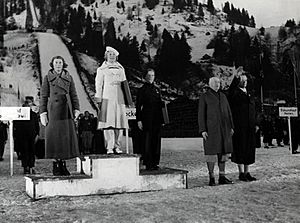
Henie won her first major figure skating competition, the senior Norwegian championships, at the age of 10. She then placed eighth in a field of eight at the 1924 Winter Olympics, at the age of eleven. Henie won the first of an unprecedented ten consecutive World Figure Skating Championships in 1927 at the age of fourteen. The results of 1927 World Championships, where Henie won in 3–2 decision (or 7 vs. 8 ordinal points) over the defending Olympic and World Champion Herma Szabo of Austria, was controversial, as three of the five judges that gave Henie first-place ordinals were Norwegian (1 + 1 + 1 + 2 + 2 = 7 points) while Szabo received first-place ordinals from an Austrian and a German Judge (1 + 1 + 2 + 2 + 2 = 8 points). Henie went on to win first of her three Olympic gold medals the following year, becoming one of the youngest figure skating Olympic champions. She defended her Olympic titles in 1932 and in 1936, and her world titles annually until 1936. She also won six consecutive European championships from 1931 to 1936.
Henie's unprecedented three Olympic gold medals have not been matched by any ladies' single skater since, nor have her achievements as ten-time consecutive World champion. While Irina Slutskaya of Russia has held the record for most European titles among ladies' skaters since 2006, Henie still retains the record of most consecutive titles, sharing it with Katarina Witt of East Germany/Germany (1983–1988).
Towards the end of her career, she began to be strongly challenged by younger skaters including Cecilia Colledge, Megan Taylor, and Hedy Stenuf. However, she held off these competitors and went on to win her third Olympic title at the 1936 Winter Olympics, albeit in very controversial circumstances with Cecilia Colledge finishing a very close second. Indeed, after the school figures section at the 1936 Olympic competition, Colledge and Henie were virtually neck and neck with Colledge trailing by just a few points. As Sandra Stevenson recounted in The Independent, "the closeness [of the competition] infuriated Henie, who, when the result for that section was posted on a wall in the competitors' lounge, swiped the piece of paper and tore it into little pieces.
The draw for the free skating [then] came under suspicion after Henie landed the plum position of skating last, while Colledge had to perform second of the 26 competitors. The early start was seen as a disadvantage, with the audience not yet whipped into a clapping frenzy and the judges known to become freer with their higher marks as the event proceeded. Years later, a fairer, staggered draw was adopted to counteract this situation".
During her competitive career, Henie traveled widely and worked with a variety of foreign coaches. At home in Oslo, she trained at Frogner Stadium, where her coaches included Hjørdis Olsen and Oscar Holte. During the latter part of her competitive career she was coached primarily by the American Howard Nicholson in London.
In addition to traveling to train and compete, she was much in demand as a performer at figure skating exhibitions in both Europe and North America. Henie became so popular with the public that police had to be called out for crowd control on her appearances in various disparate cities such as Prague and New York City.
It was an open secret that, in spite of the strict amateurism requirements of the time, Wilhelm Henie demanded "expense money" for his daughter's skating appearances. Both of Henie's parents had given up their own pursuits in Norway—leaving Leif to run the fur business—in order to accompany Sonja on her travels and act as her managers.
Professional and film career

After the 1936 World Figure Skating Championships, Henie gave up her amateur status and took up a career as a professional performer in acting and live shows. While still a girl, Henie had decided that she wanted to move to California and become a movie star when her competitive days were over, without considering that her strong accent might hinder her acting ambitions.
Henie opened up opportunities for figure skaters to use their skills to earn a living. In addition to appearing in Hollywood films, she toured North America with her own professional shows, thus amassing a great deal of personal wealth and by popularizing the ice show, opened up professional skating opportunities for other lesser-known figure skaters.
In 1936, following a successful ice show in Los Angeles orchestrated by her father to launch her film career, Hollywood studio chief Darryl Zanuck signed her to a long-term contract at Twentieth Century Fox, which made her one of the highest-paid actresses of the time. After the success of her first film, One in a Million (1936), Henie's position was assured and she became increasingly demanding in her business dealings with Zanuck. Henie also insisted on having total control of the skating numbers in her films such as Second Fiddle (1939).
Henie tried to break the musical comedy mould with the anti-Nazi film Everything Happens at Night (1939) and It's a Pleasure (1945). It was her only film shot in Technicolor, but it was not as huge at the box office as her other films and also proved her limitations as a dramatic actress in her only dramatic film.
When Zanuck realized this, he cast her in more musical comedies; Sun Valley Serenade (1941) with Glenn Miller, John Payne, The Nicholas Brothers, and hit songs such as "In the Mood", "Chattanooga Choo Choo", "It Happened in Sun Valley", and "I Know Why (And So Do You)"; followed by Iceland (1942) with Jack Oakie, Payne, and the hit song "There Will Never Be Another You"; and finally Wintertime (1943) with Cesar Romero, Carole Landis, Cornel Wilde, and Oakie. Sonja had by now developed a comedy flair and these films were all among the top box-office hits for 20th Century-Fox the respective years. Eight Sonja Henie movies crossed the $100 million domestic gross mark. Happy Landing (1938) was her biggest box office hit.
In her film Everything Happens at Night (1939), Ray Milland and Robert Cummings star as rival reporters hot on the trail of Hugo Norden (Maurice Moscovich). Released on 22 December 1939, it was banned in Nazi Germany.
She was among 250 female stars who were nominated for "50 Greatest Screen Legend" status by the American Film Institute. She did not make the final list however.
In addition to her film career at Fox from 1936 to 1943, Henie formed a business arrangement with Arthur Wirtz, who produced her touring ice shows under the name of "Hollywood Ice Revue". Wirtz also acted as Henie's financial advisor. At the time, figure skating and ice shows were not yet an established form of entertainment in the United States. Henie's popularity as a film actress attracted many new fans and instituted skating shows as a popular new entertainment. Throughout the 1940s, Henie and Wirtz produced lavish musical ice skating extravaganzas at Rockefeller Center's Center Theatre attracting millions of ticket buyers.
At the height of her fame, Henie brought as much as $2 million per year from her shows and touring activities. She also had numerous lucrative endorsement contracts, and deals to market skates, clothing, jewelry, dolls, and other merchandise branded with her name. These activities made her one of the wealthiest self-made women in the world in her time.
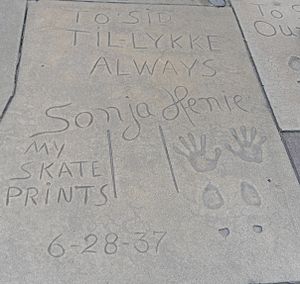
Henie broke off her arrangement with Wirtz in 1950 and for the next three seasons produced her own tours under the name "Sonja Henie Ice Revue". It was an ill-advised decision to set herself up in competition with Wirtz, whose shows now featured the new Olympic champion Barbara Ann Scott. Since Wirtz controlled the best arenas and dates, Henie was left playing smaller venues and markets already saturated by other touring ice shows such as Ice Capades. The collapse of a section of bleachers during a show in Baltimore, Maryland in 1952 compounded the tour's legal and financial woes.
In 1953, Henie formed a new partnership with Morris Chalfen to appear in his European Holiday On Ice tour, which proved to be a great success. She produced her own show at New York's Roxy Theatre in January 1956. However, a subsequent South American tour in 1956 was a disaster. Henie could no longer keep up with the demands of touring, and this marked her retirement from skating.
She did try to make a film series at her own expense; a series that would serve as a travelogue to several cities. Paris and London were mentioned, but only Hello London (1958) was made with her own backing, co-starring Michael Wilding and special guest star Stanley Holloway. While her ice show numbers were still worth watching, the film received few distributors and poor reviews, ending her film career.
Her autobiography Mitt livs eventyr was published in 1938. An English translation, Wings on My Feet, was released in 1940 and republished in a revised edition in 1954. At the time of her death, Henie was planning a comeback for a television special that would have aired in January 1970. She was to have danced to "Lara's Theme" from Doctor Zhivago.
As international celebrity
Henie's connections with Adolf Hitler and other high-ranking Nazi officials made her the subject of controversy before, during, and after World War II. During her amateur skating career, she performed often in Germany and was a favorite of German audiences and of Hitler personally. As a wealthy celebrity, she moved in the same social circles as royalty and heads of state and made Hitler's acquaintance as a matter of course.
Through the years, her shows and later art exhibitions drew the attention of such people as Princess Margaret, Countess of Snowdon and Gustaf VI Adolf of Sweden and she met with them. During the shooting of Second Fiddle (1939), she greeted the then Crown-Prince couple of Norway Olav and Märtha during their US tour.
Controversy appeared first when Henie greeted Hitler with a Nazi salute at the 1936 Winter Olympics in Garmisch-Partenkirchen and after the Games she accepted an invitation to lunch with Hitler at his resort home in nearby Berchtesgaden, where Hitler presented Henie with an autographed photo with a lengthy inscription. She was strongly denounced in the Norwegian press for this.
In her revised 1954 biography, she states that no Norwegian judge was in the panel for the 1936 Olympics—as she was entitled to as a Norwegian. She therefore made the best of it and won her third Olympic medal. When she—as a gold medal winner—passed Hitler's tribune with silver medalist Cecilia Colledge and bronze medalist Vivi-Anne Hultén, neither she nor the others honored Hitler with the Nazi salute. The 1936 European Figure Skating Championships also took place in Berlin and neither Henie, Colledge, nor Megan Taylor paid obeisance to Hitler.
The royal family were very mindful of whom they supported after the war and Norwegians looked to them as role models in that respect.
Influence
Henie is credited with being the first figure skater to use dance choreography, to adopt the short skirt in figure skating, and to wear white boots, which deemphasized the heaviness of skates and produced a lighter and longer appearance of the skater's legs that was "a focal point for judges' and spectators' gaze". When white boots quickly became standard for female skaters, Henie began wearing beige boots because she wanted to remain unique.
Her innovative skating techniques and glamorous demeanor transformed the sport permanently and confirmed its acceptance as a legitimate sport in the Winter Olympics. Figure skating writer and historian Ellyn Kestnbaum credits Henie with transforming figure skating into what she calls "a spectacle of the skater's body" and for "shifting [the sport's] meanings firmly in the direction of femininity". Kestnbaum argues that Henie influenced female skaters' costumes that emphasized their wealth, especially her fur-trimmed outfits, which were emulated at the 1930 World Championships, held for the first time in North America, in New York City. Henie incorporated dance elements into her figure skating, through the placement of spins, jumps, and choreography to reflect the mood of the music she used.
Kestnbaum argues that although Henie's skating was "athletic and powerful for her day", she purposively added elements,such as using the toepicks of her skates to run or pose on the ice, in movements similar to the use of pointe technique in ballet, that undercut her power and athleticism. Kestnbaum states that although toe steps are used as "occasional couterpoints to the legato flow of skating movement", she argues that Henie might have overused these steps, calling them "mincing and ineffective".
Also according to Kestnbaum, "Henie's largest contribution to public images of skating" was in her professional ice shows and in her Hollywood films, which were often the first time audiences were exposed to figure skating through the mass media. As a result, the image of the figure skater was linked to "the image of the glamorous movie star", within the conventions of film and stage musicals of the 1930s. Kestnbaum argues that the costumes Henie wore in her shows and films, which were short, revealing, full of sequins and feathers, and more reminiscent of the costumes of female entertainers than of the clothes worn in the more conservative world of competitive figure skating of the time, most likely contributed to the "showiness" that influenced the costume choices of later generations of female competitive figure skaters.
Personal life
Henie was married three times, to Dan Topping (1940–1946), Winthrop Gardiner Jr. (1949–1956), and the Norwegian shipping magnate and art patron Niels Onstad (1956–1969). After her retirement in 1956, Henie and Onstad settled in Oslo and accumulated a large collection of modern art that formed the basis for the Henie Onstad Art Centre at Høvikodden in Bærum near Oslo.
She studied in Oslo together with Martin Stixrud and Erna Andersen who was her competitor and skate club member.
Henie was diagnosed with chronic lymphocytic leukemia in the mid-1960s. She died of the disease at age 57 in 1969 in an ambulance plane flight from Paris to Oslo. She is buried with Onstad in Oslo on the hilltop overlooking the Henie Onstad Art Centre.
Results
Ladies' singles
| Event | 1923 | 1924 | 1925 | 1926 | 1927 | 1928 | 1929 | 1930 | 1931 | 1932 | 1933 | 1934 | 1935 | 1936 |
|---|---|---|---|---|---|---|---|---|---|---|---|---|---|---|
| Winter Olympics | 8th | 1st | 1st | 1st | ||||||||||
| World Championships | 5th | 2nd | 1st | 1st | 1st | 1st | 1st | 1st | 1st | 1st | 1st | 1st | ||
| European Championships | 1st | 1st | 1st | 1st | 1st | 1st | ||||||||
| Norwegian Championships | 1st | 1st | 1st | 1st | 1st | 1st | 1st |
Pairs
(with Arne Lie)
| Event | 1926 | 1927 | 1928 |
|---|---|---|---|
| World Championships | 5th | ||
| Norwegian Championships | 1st | 1st | 1st |
Awards
- Inducted into the World Figure Skating Hall of Fame (1976)
- Inducted into the International Women's Sports Hall of Fame (1982)
- She has a star on the Hollywood Walk of Fame.
- In 1938, at age 25, she became the youngest person to be made a knight first class of The Royal Norwegian Order of St. Olav.
- Honorary Colonel and Godmother of the 508th Parachute Infantry Regiment, 82nd Airborne Division, Fort Bragg, North Carolina
Filmography
| Year | Title | Role |
|---|---|---|
| 1927 | Seven Days for Elizabeth | Skater |
| 1929 | Se Norge | Herself |
| 1936 | One in a Million | Greta "Gretchen" Muller |
| 1937 | Thin Ice | Lili Heiser |
| Ali Baba Goes to Town | Herself | |
| 1938 | Happy Landing | Trudy Ericksen |
| My Lucky Star | Krista Nielsen | |
| 1939 | Second Fiddle | Trudi Hovland |
| Everything Happens at Night | Louise | |
| 1941 | Sun Valley Serenade | Karen Benson |
| 1942 | Iceland | Katina Jonsdottir |
| 1943 | Wintertime | Nora |
| 1945 | It's a Pleasure | Chris Linden |
| 1948 | The Countess of Monte Cristo | Karen Kirsten |
| 1958 | Hello London | Herself |
Other appearances
- For a time, Sonja Henie's picture adorned the tail of a Boeing 737-300 of the airline Norwegian Air Shuttle. As the Boeing 737-300 was being phased out, her picture was placed on the tail of a Boeing 737-800 of the same airline and in 2013 to the tail of Norwegian Air Shuttle's first Boeing 787 Dreamliner. One of the airline's trademarks is having portraits of famous deceased Norwegians on the tails of its aircraft.
- In 2012, the Posten Norge (Norwegian postal service) issued two stamps featuring Sonja Henie.
See also
 In Spanish: Sonja Henie para niños
In Spanish: Sonja Henie para niños


